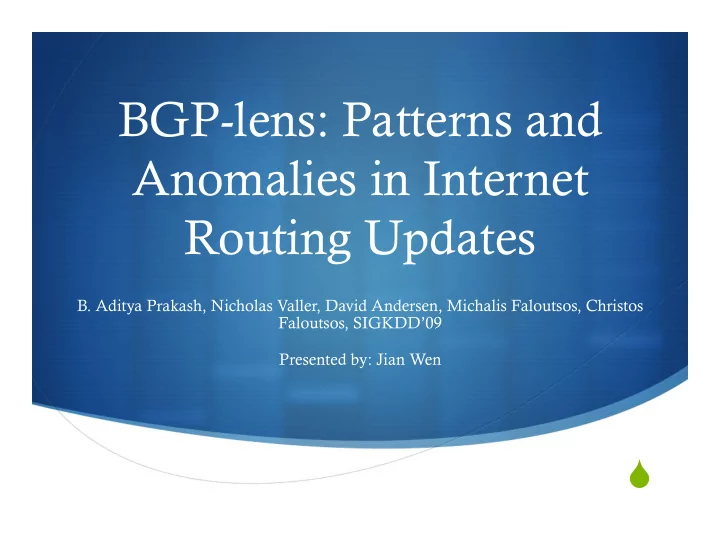

BGP-lens: Patterns and Anomalies in Internet Routing Updates B. Aditya Prakash, Nicholas Valler, David Andersen, Michalis Faloutsos, Christos Faloutsos, SIGKDD’09 Presented by: Jian Wen �
What’s Happening in BGP? Routing information in a BGP network is updated frequently. Why? Link/node failure, router maintenance, misconfigure. From these updates: What is the normal pattern? What does the anomalies look like (Route Flapping, Hijacking)?
Anomalies
Problem Definition Given: BGP updates. Problem: Find patterns and anomalies. Out Approach: BGP-lens!
Existing Work/Solutions Network: BGP measurement and analysis Canonical measurement and models for BGP anomalies and instability behaviors. Not really handy. Detect network-wide BGP anomalies. Not for fine granularity. Visualization and statistic methods. Data Mining?
BGP-lens A novel tool for automatically detecting patterns and anomalies in BGP updates at many different scales of observation. Effective: Can detect both temporal and frequency anomalies. Scalable: The algorithms are linear on the number of time-ticks and thus it can handle large datasets. Admin-friendly: It can work with zero user input; automotive detection.
Roadmap Tool Components and Observations in BGP-lens The Clothesline Effect - Temporal Analysis The Tornado Plots - Frequency Analysis Automating Discovery Scalability User-interface: BGP-lens as an administrative tool BGP-lens at work
Temporal Analysis: Clothesline Linear-linear plots fail to show short duration spurts. Threshold method cannot deal with the huge variations. FFT cannot work here due to the burstiness of the updates.
Temporal Analysis: Clothesline Instead of using linear-linear plots, we use log-linear plots. No striking outliers any more; The “bin size”, or the window size for the measurement, now means a lot: clothesline! Clothesline: a periodic update stream over a prolonged time period (so it may be Route Flapping).
Catch the Clothesline: Marginals Outliers in the “marginal” distribution usually correspond to clotheslines. Marginal distribution plot Log-log scale; PDF of Occurrence count on Number of updates
Frequency Analysis: Tornado Due to the self-similar nature of the data, Fourier Transformation doesn’t work well for our purpose. Discrete Wavelet Transform and scalogram. Observations. Pronounced spikes correspond to “tornadoes” that touch down. Darker tornado => Larger spike. Non-touch-down tornado => Prolonged spike.
Real “Tornados” E1: A huge touch-down spike (one hour’ prefix hijacking). E2: A dark non-touch- down spike (eight hours’ sustained update activities).
Automating the Discovery Clotheslines Find longest time interval for outliers. Get marginal plot, find outliers.
Automating the Discovery Clotheslines For each time bin size b=2 i , derive the corresponding marginal plots. Multiple plots corresponding to different i value. For each marginal plot use the median filtering approach to determine “outliers”. Median Filter Approach: reduce the noise and pick the median for output. For each outliers found, find the longest time-interval from the corresponding clothesline plot. For each time interval found, report the most consistent IPs or ASes etc.
Automating the Discovery Prolonged Spike (Tornadoes) Require two inputs: sensitivity and duration Sensitivity: the percentage of the DWT coefficients to be considered, which refers to the strength of the spike (recall: larger coefficient -> darker scale cell -> larger spike). Duration: the time threshold for the spike’s duration. BGP-lens provides the default input of these two parameters. Only consider wavelet coefficients within 60% of the maximum with duration at least 2 len-8+1
Scalability of BGP-lens Top-5 anomalies. Two AMD Opteron dual-core 2.4GHz, 48G Mem, Fedora 5 Data size: > 18 million updates for two years.
User Interface Install and run! No more configuration! Beginner/ Expert Mode
BGP-lens on Duty: Clotheslines
BGP-lens on Duty: Prolonged Spikes
Summary BGP-lens: handy tools for administrators to monitor BGP updates. Efficient, scalable, and admin-friendly. Support anomalies detection on both updates bursts and prolonged spikes. The paper also covers some interesting observations: Marginals that are mixture of log-normals with a power-law tail. Self-similarity of BGP updates data corresponding to a 75-25 b- model slope.
Future Work On-line Monitoring Tool? Incremental algorithms. Arbitrary time instance and duration.
Recommend
More recommend